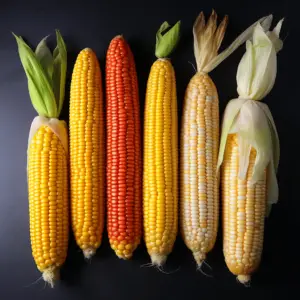Corns are famous as vegetables for good reasons. They are cultivated from native plants that are easy to grow and manage. In addition, the crop is available in a wide range of sizes, colors and shapes, making it the perfect addition to any farm.
When it comes to nutritional profile, corns are heavily packed with antioxidants, fibre and vitamins, among others. All the nutrients help all the body systems.
The crop can also be enjoyed in diverse ways, which include eating them fresh, cooking, preserving, converting to flour or popping them into popcorn.
You might have come across the two famous corns: Serendipity corn and Peaches and Cream. Both have a memorable taste and serve similar functions. However, they have slight variations in maturity period that can’t be easily identified. Therefore, anyone can easily fall into a dilemma when trying to choose between the two.
How can you differentiate between Serendipity corn and Peaches and Cream? Keep reading to know the key features of the two main corn varieties and the right option you can choose for your home or any other environment.
Table of Contents
Serendipity Corn Vs Peaches and Cream: Comparison Table

| Specifications | Serendipity Corn | Peaches and Cream |
| Planting Method | Direct seed | Direct seed |
| When to Plant | After last frost (Early Spring) | After last frost(Early Spring) |
| Planting Depth | 1″ | 1″ |
| Seed Spacing | 6-8″ | 6-8″ |
| Row Spacing | 30-36″ | 30-36″ |
| Days to Maturity | 80 | 75 |
| Disease Tolerance | Southern Corn Leaf Blight | None |
Serendipity Corn Overview
A hybrid TripleSweet corn type called Serendipity Sweet Corn strikes the ideal combination of sweet, soft kernels and classic corn flavour. This type thrives in all climatic environments and is widely adaptable.
Bicolor ears from Serendipity are typically 8 inches long. The plants are robust and grow quickly, reaching approximately 6-7′ tall. Serendipity Sweet Corn blends sweetness and suppleness with 75% supersweet kernels and 25% kernels treated with sugar.
The ears stay firmly attached to the stalk due to the significant proportion of supersweet kernels. That opens up a wider window for harvesting and processing.
Plant the serendipity corn after the last day of cold in the early spring. As long as there is time to harvest the crop before the first frost, sweet corn may be planted from the spring through the fall.
It’s advised that you plant a minimum of two seeds for succession: one in the early spring and another in the late summer or early fall. In the warmer months, corn ear parasites are increased, but this may be reduced by spraying spinosad on silks and tassels as soon as they arise.
When planting the Serendipity, you can use the Hoss Garden Seeder. Depending on the amount of available water, thin plants grow up to 6–8′′ tall.
When drip watering, in-row spacing should be as small as 6″. Larger in-row spacing is required if water is in short supply.
Serendipity corn should be planted in a square plot with rows spaced 30-36′′ apart for pollination benefits. Few, lengthy planting rows will lead to poor plant growth and a shortage of kernels on the cobs.
Peaches and Cream Overview
Each Peaches and Cream Sweet Corn bite delivers two distinct sensations due to its bicolour mix of white and yellow kernels. Peaches and Cream is a name that promises quality.
It matures a bit earlier than Serendipity and other ordinary corn types since it’s a sugary-enhanced variety. Peach and Cream is sweet corn with added sugar that stays fresh for an extended period in cold storage, mostly for up to 10 days.
The 8.5-inch-long ears of Peaches and Cream Sweet Corn are well-covered and safeguarded by the plants’ long flags. It’s renowned for its fresh eating capabilities, but it also functions well when processed and stored in bags for later use.
Like the Serendipity corn, it’s recommended that you plant Peaches and Cream in early spring. You can plant them at any time between spring and fall as long as you believe time for harvesting the crop will be available.
Plant a minimum of two Peaches and Cream seeds for proper succession. That means you can plant one in the early spring and the other in the late summer or early fall.
In the warmer months, there is a higher prevalence of corn earworms. You can manage and control their dominance by using the recommended chemicals sprayed on tassels and silks.
Peaches and Cream
Planting Peaches and Cream in cold soil runs the risk of poor germination. Under 60°F, even pretreated corn seeds face the possibility of poor germination.
If warmer weather is expected, only pretreated seeds of excellent cold-germinating genotypes should be sown in soil that is 55°F. When the ground is warm, at least 65°F, you can plant untreated seeds.
Early plants may benefit from the use of floating row covers to help control soil temperature. The characteristics tab for each corn type will indicate whether it has been treated or not. Keep non-Super Sweet maize at least 300 feet away from Super Sweets varieties.
Rows of Peaches and Careams should be spaced 30-36 inches apart. Sow 3/4 to 1 inch deep, 6-7 inches apart (pretreated) and 4-5 inches apart (untreated).
To ensure proper pollination, which is required for well-filled ears, organize Peach and Cream seeds in blocks of at least four rows.
At the start of the summer, you can do successive planting of Peaches and Cream. Still, most producers prefer to stretch the corn season by planting different varieties with varying maturity periods.
Peaches and Cream corn should be spaced 8 to 12 inches apart until it reaches a height of 4 inches. In addition, it should be well-watered because of its shallow roots. It needs 5 gallons of water per square foot.
Since corn is designed to develop quickly and is a demanding plant, fertilizer may be used at the time of planting. Peaches and Cream and Serendipity corn should be fertilized every 30 days.
How Do Peaches and Cream Corn Test?

Peaches and Cream are among the sweetest corn varieties. This most tender sweet corn is a tasty gourmet bicolor variation with exquisite yellow and white kernels. Peaches and Cream mature to a desirable bicolor with a sweet taste early.
Is Serendipity Corn Good?
Yes. Bicolor kernels from Serendipity are succulent, soft, and have the ideal ratio of sweet sugary flavour to conventional corn flavour. It has 8-inch-long ears that are stuffed full of air.


